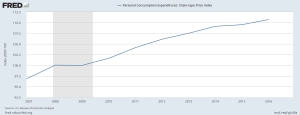Why Yellen Must Hike Rates In March
Earlier this week Fed Chairwoman Janet Yellen delivered her Semi-annual Monetary Policy Report to Congress. Pundits expected the report to be business as usual ... maintain the course of low interest rates until the Fed's 2% inflation target was met or exceeded. Below is what she had to say and my interpretation:
Yellen On Tightening Labor Market
The economy has continued to make progress toward our dual-mandate objectives of maximum employment and price stability. In the labor market, job gains averaged 190,000 per month over the second half of 2016, and the number of jobs rose an additional 227,000 in January. Those gains bring the total increase in employment since its trough in early 2010 to nearly 16 million. In addition, the unemployment rate, which stood at 4.8 percent in January, is more than 5 percentage points lower than where it stood at its peak in 2010 and is now in line with the median of the Federal Open Market Committee (FOMC) participants' estimates of its longer-run normal level.
Author's Interpretation:
President Obama has been criticized for creating jobs with low wages like waiters and bartenders - the types of jobs that cater to the elite and their leisure activities. President Trump worked the country into a frenzy over the loss of high-paying manufacturing, jobs and the outsourcing of U.S. jobs to countries with lower wages. Nonetheless, the 4.8% unemployment rate was encouraging. The fact that the labor participation rate ticked up from 62.9% from 62.7% in December and 62.7% in the year earlier period was also big deal - such rates have not been this low since the late 1970s. If more people can return to the labor force in 2017 that could be a tremendous win for the economy.
Hourly earnings, formerly a sticking point for critics, was up 2.9% Y/Y. It was the fastest wage growth since 2009. The average work week ticked up 1% Y/Y, which helped drive weekly earnings up 3.8%. It was an excellent send off for President Obama and might have been enough for Yellen to hike rates.
Yellen On Inflation
Inflation moved up over the past year, mainly because of the diminishing effects of the earlier declines in energy prices and import prices. Total consumer prices as measured by the personal consumption expenditures (PCE) index rose 1.6 percent in the 12 months ending in December, still below the FOMC's 2 percent objective but up 1 percentage point from its pace in 2015. Core PCE inflation, which excludes the volatile energy and food prices, moved up to about 1-3/4 percent.
My Interpretation
The Fed uses personal consumption expenditures ("PCE") as the metric to measure inflation. Its target is 2%.

The index grew 1.6% in 2016 and has never reached 2% since the Financial Crisis. Experts now ponder whether the Fed will wait until PCE exceeds 2% or hike rates with the anticipation that the 2% target will be reached or exceeded.
While not necessarily spurring economic growth, the Fed has created distortions in the real estate and stock markets. It has raised asset prices that have inured to the benefit of the investor class. Some could argue that the Fed is "picking the winners" - the investor class over the general population.
Fed On Gradual Rate Increases
The Committee's view that gradual increases in the federal funds rate will likely be appropriate reflects the expectation that the neutral federal funds rate - that is, the interest rate that is neither expansionary nor contractionary and that keeps the economy operating on an even keel - will rise somewhat over time. Current estimates of the neutral rate are well below pre-crisis levels - a phenomenon that may reflect slow productivity growth, subdued economic growth abroad, strong demand for safe longer-term assets, and other factors. The Committee anticipates that the depressing effect of these factors will diminish somewhat over time, raising the neutral funds rate, albeit to levels that are still low by historical standards.
My Interpretation:
I agree that gradual rate increases are appropriate. Eight years of record low rates have kept the economy from sinking, but also have created the distortions I mentioned earlier. Lawmakers also appear to be hiding behind Yellen's skirt. Had the Fed not been so "accommodative" over the years, it could have potentially prompted lawmakers to craft a strong fiscal policy a lot sooner.
The Fed has lost a lot of credibility with the public and certain members of the investment community. Economic growth has been anemic, yet the Dow Jones (DIA) sits above 20,000, partly driven by Fed stimulus. The government should be spurring the economy, not just asset prices.
Takeaway
In my opinion, for the Fed to gain any semblance of credibility it must normalize interest rates and let policymakers focus on spurring the economy. A March rate hike could mark the beginning of that effort.



